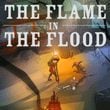The Flame in the Flood Review – Unsatisfying survival game from the creators of BioShock
The Flame in the Flood is yet another survival game, similar to hundreds of others out there. Nice audiovisuals and an intuitive crafting system are not enough to completely forget about its repetitivness and lack of variety.
The review is based on the PC version.
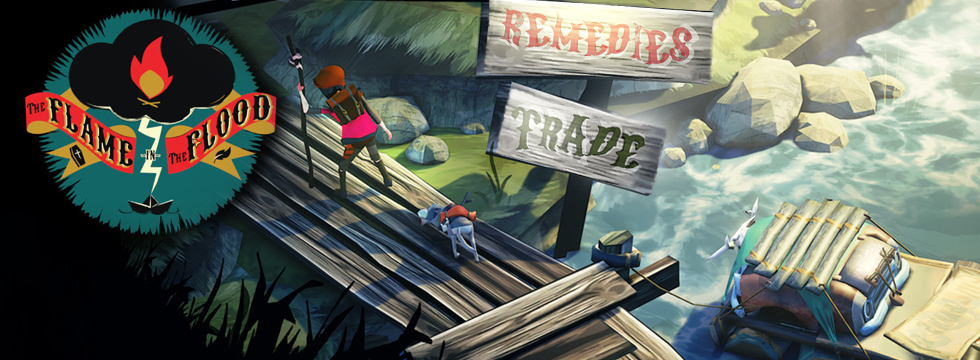
- pleasant atmosphere, reminiscent of the southern regions of the US;
- simple, intuitive crafting system;
- art style and location design.
- repetitiveness and general lack of diversity;
- lacks incentives to keep you playing;
- little variety in all aspects.
Here's an old one. A developer that boasts having worked for well-known publishers establishes a fully independent studio, and the money for their first project is to be raised via Kickstarter. They promise to deliver a great game, and the gamers put trust (and money) in their declaration. No one is bothered by the fact that the game is to be, once again, a survival game, because this one will definitely be unlike any other before. Thus The Flame in the Flood was born, a game that – as if to spite the developer's inflated declarations – turns out to be just another cookie cutter that may meet the basic requirements of the genre, but fails miserably when it comes to delivering that "something".
A girl and her dog – Scout and Aesop – are the main characters of this production from The Molasses Flood. Could anything bad possibly happen to such an innocent duo? Of course it could; they just have to find themselves lost in a dangerous forest situated in the vicinity of a river full of desolate islands – in the wake of an apocalypse, in short. That’s why they have no choice but to rely on each other – armed with Scout's stick and a raft that will carry them through the river’s currents towards the game's vague ending, the two of them have to survive while searching the landings they encounter along the way for supplies and a place to rest. As it often is the case in survival games, the gameplay core of The Flame in the Flood revolves around the feeling of isolation and the struggle to provide for the basic needs of a human being while avoiding confrontation with dangerous creatures that somehow managed to survive after the flood drowned the whole human race. There would be nothing wrong with that if not for the fact that the game's mechanics can be summarized as briefly and efficiently as its plot. The Flame in the Flood, while it does have a narrative of sorts, lacks characters, dialogue, vision, and, as a consequence, any significant (excluding survival) factors that would encourage us to continue the game after having died for the nth time. Even the creators seem to agree with this, seeing as they summarize the main points of their production in the pause menu. It's as if the game did not deserve a more elaborate presentation.
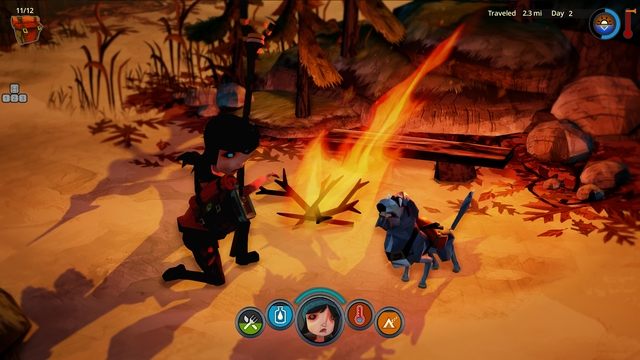
Almost like Hotline Miami
Life in the fleeting (floating?) world of The Flame in the Flood is a rare thing, and we should treasure it – easier said than done, though. The passage of time is relentless, rest can come only by the fire or on the back of a rusty bus, the plant roots we find here and there will hardly satisfy our hunger, and drinking water from an unknown source can lead to an infection. If Scout wants to make it alive to the end of this rafting course, she has to survive under such harsh conditions for as long as possible, cooking meals, filtering water, taking care of the raft, hunting animals or sewing suitable clothing, which, once again, is a much more difficult task than it sounds. All the components necessary to perform the aforementioned tasks must first be located on the right island, and then used to craft something that provides the necessary utility.
The crafting mechanics underlying the premise of the gameplay are simple, intuitive, and "scalable" in a very typical way; some items wear out and are eventually destroyed, others may be crafted only if the schematic or a basic version of the item is already in our inventory. The importance of specific resources is fairly well-balanced; once we learn the ropes, we can determine what to keep on ourselves, what to pack on Aesop’s back just in case, and what to leave on the raft. Unfortunately, the crafting system lacks something – be it sybstance or a pinch of originality – that would make the creation of subsequent items and improvements engaging in any way. Strategic crafting in The Flame in the Flood was replaced completely with ad hoc crafting, and side quests that were aimed at drawing attention to the construction of each item make the perfect impression of having been crammed into the game by force. Thus, we will be able to survive in this hostile environment for as long as we'll be lucky enough to find the raw materials necessary to create basic tools – and by then, the boredom will be getting more painful than hunger.
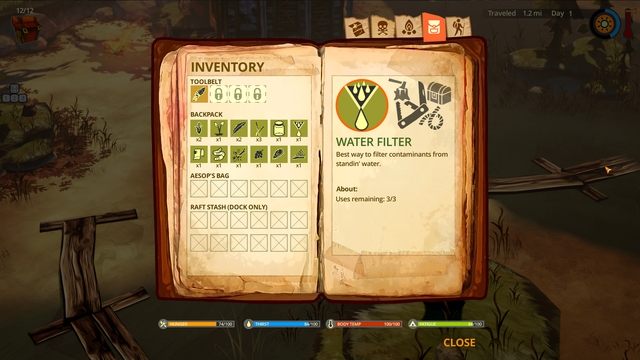
Simultaneously, the difficulty level is quite high, mainly due to the hostile monsters inhabiting numerous locations. Defenseless for the majority of the game, Scout becomes a punching bag for the predators roaming the islands, including wild boars, bears, and grotesque wolves, and the only way to deal with them is by using appropriate, resource-consuming traps. That’s why visits to individual sites often end up with you making a quick exit when chased by bloodthirsty, inhuman (literally and figuratively) enemies. In addition to the constantly decreasing meters of basic needs, our survival is hindered even further by the changing weather conditions (i.e. chilly rain that puts out campfires and deprives your body of heat). As a result, Scout can change from being a specimen of health into a half-dead skeleton in the span of just a few seconds. Luckily, in order to give the heroine equal opportunities in her fight against the nature, every now and then we meet mysterious figures that grant us selfless, humanitarian favors, including things like healing or providing a free meal. Here's the game's survival aspects in a nutshell: needs and enemies versus luck and no luck at all. And there we have it: the genre's basic premises are all there. The difference is that, unlike in The Long Dark for example, their implementation falls terribly short of being brilliant and doesn't even try to find a thematic justification for itself in the game.
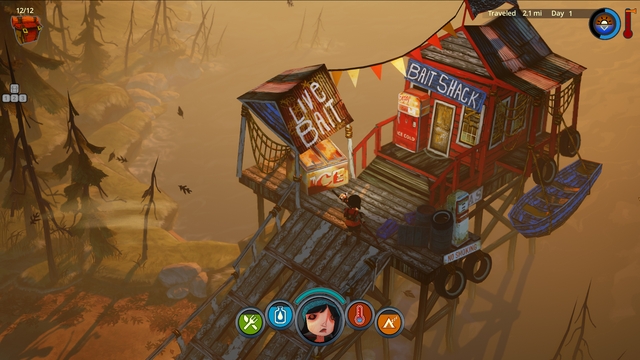
Furthermore, our death means only a partial end of the game – should we be prudent enough to hand over a part of our resources to Aesop before we died, it will remain in his inventory. This feature, seemingly a small nod to casual gamers, turns out to be the driving force behind the game's replayability, freeing us from the necessity of re-acquiring everything from scratch with each restart. Going even further, our adventure does not have to begin from square one – the basic difficulty level provides us with the option to respawn in one of the checkpoints, assuming we have reached it beforehand.
Going down the river
The time that flows by as we play The Flame in the Flood is spent largely on... floating. Sitting on the raft, Scout with Aesop float down the capricious river - capricious, not only because every now and then it becomes more turbulent and tries to guide the two protagonists in the direction of the boulders protruding from the water, which means damage to their means of transport and forces them to locate a workshop. Its dangerous nature stemps from the distribution of islands that allow docking – they are way too far from each other. Taking into account the fact that swimming against the current is not an option, we are forced to make a choice: do we dock at the workshop to repair the raft, knowing that it will be at the expense of being unable to reach the station on the other side of the river where we could probably find something to drink? The gravity of this decision (which, by the way, raises the general difficulty) becomes clear to us only when we have to choose between dying a bit slower or a bit faster - from starvation or dehydration (food's on this island; drinks are on the other one, sorry), from festering wounds or by drowning (bandages are on that one; I don't know if my battered raft can reach it though...). This spark of designer genius – an interesting combination of the game's premise and mechanics – is unfortunately the only real bright side that somehow stands out among its general mediocrity. Still, despite the fact that our floating piece of wood will, over time and with the right upgrades, transform into a state-of-the-art yacht equipped with all possible facilities, it will continue to serve us primarily as a means of transport. And so on.
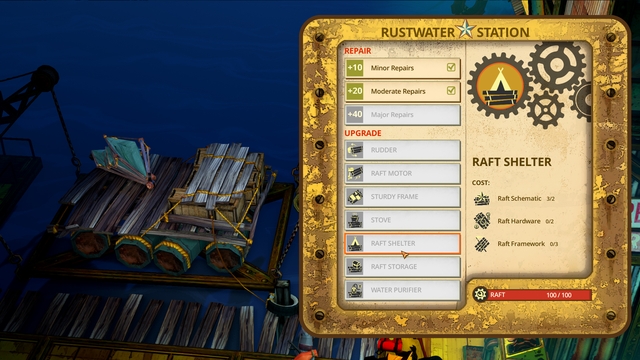
The world was intended to give off the vibe of the abandoned southern regions of the United States – thus, we get a Mississippi-like river (the central point of the map), lots of trees and swamps reminiscent of Louisiana, a rustic confederate soul of the individual portions of the land, and angular 3D models that provide the adventure with a comic book-like aura. Proper lighting and color balance (especially when the weather conditions change), combined with small yet eye-pleasing elements (such as dynamic reflections on the water surface), add some flavor to the game. Unfortunately, it doesn't take much for the repetitiveness of the randomly generated islands to completely replace the initial infatuation with the game's artistic qualities, as it relentlessly serves us another dose of monotony. After a short while, even the change of decorations and atmosphere introduced with each new region is not enough to offset the issue - wherever we dock, we will be accompanied by the constant feeling of déja vu. Unfortunately, a good survival game requires something more than atmosphere and nice visuals.
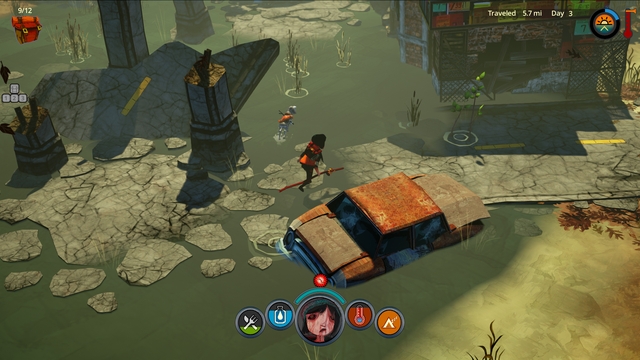
The in-game atmosphere itself is actually built by the music – but only occasionally. The folk soundtrack from Chuck Ragan – although pleasant to the ear and overall a good moodsetter – encountered playback issues more than once in every 30 minutes, at least in the version I was testing. Therefore, Scout and Aesop persisted in silence, in the aftermath of some kind of a bug apparently. That's when it hit me. Doesn't this little shortcoming, ever so slightly disrupting the integrity of the whole game, perfectly describe The Flame in the Flood in general?
And off they floated
The Molasses Flood's self-proclaimed masterpiece is nothing more than a typical, cookie-cutter survival game, devoid of imaginativeness, but consistent in its occasional, impossible to overlook deficiencies. It wants to feature an intriguing storyline – yet it lacks one. It wants to present a big, one-of-a-kind challenge, but its mechanics lack any above-average elements. It wants to be unique, but turns out to be anything but. It wants to treat the player to a pleasant audio experience – but lacks the skill and refinement to play the music at the right moments. The Flame in the Flood gave everything it had to a single vision around which the studio had built the entire mechanics. Unfortunately, somewhere mid-development the creators got a little tangled up and it would seem that they have forgotten what exactly was their game supposed to be like. As a result, the game has become something moderately tasty (but far from being a delicacy) for fans of the genre, leaving anyone else indifferent.
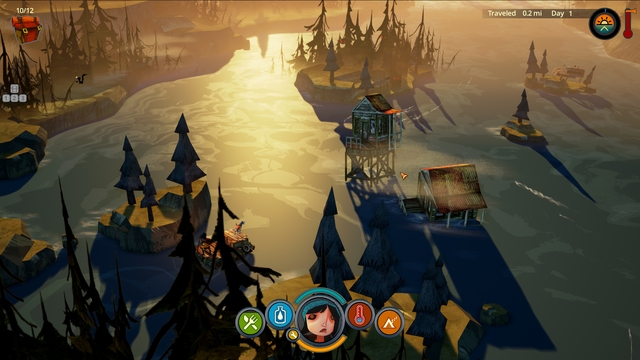
The Flame in the Flood
The Flame in the Flood Review – Unsatisfying survival game from the creators of BioShock
The Flame in the Flood is yet another survival game, similar to hundreds of others out there. Nice audiovisuals and an intuitive crafting system are not enough to completely forget about its repetitivness and lack of variety.

